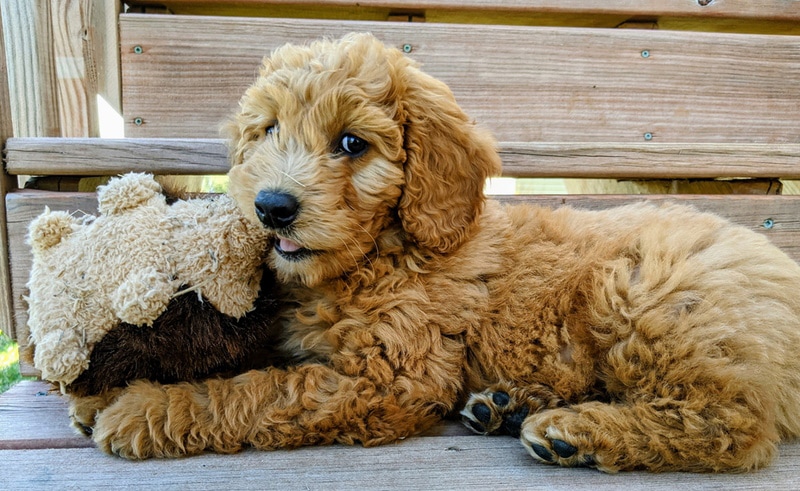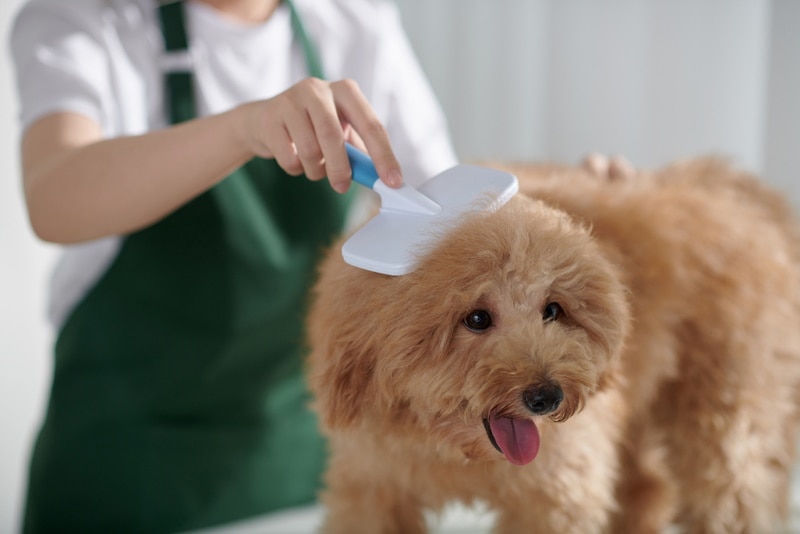Click Below to Skip Ahead
Goldendoodles have become extremely popular over the last decade, but have you heard of English Goldendoodles? While regular Goldendoodles represent a mix between American Golden Retrievers and Poodles, the English version mixes English Golden Retrievers and Poodles.
English Goldendoodles have inherited many of the best traits from their parent breeds, so these dogs are loyal, intelligent, active, and outgoing. They make excellent pets due to their people-loving nature and adventurous spirit.
Breed Overview
Height:
13 – 20 inches
Weight:
15 – 35 pounds
Lifespan:
12 – 15 years
Colors:
Apricot, chocolate, blue, cream, red, silver, white, brindle, sable, tan, champagne, particolored, etc.
Suitable for:
Active families, those looking for a low-shedding dog, people with kids, couples, any dog lovers
Temperament:
Loyal and loving, intelligent, easy to train, friendly, affectionate, social, gets along with other pets
One of the most interesting things about English Goldendoodles is that these dogs typically have low-shedding coats that don’t require much maintenance, which means these dogs are extremely easy to care for. If you’re considering getting an English Goldendoodle but would like to know more about this unique breed, you came to the right spot! Here, we provide you with essential information about this breed that will help you understand them better and see if you’d be a good fit for one.
English Goldendoodle Characteristics
English Goldendoodle Puppies

English Goldendoodles puppies are loyal and active and love to spend time with their family. These little canines have an excellent attitude, as they’re playful and keen to learn new things.
Like most dogs during their puppy stage, English Goldendoodles will usually spend this period playing, sleeping, and socializing with others. You’ll need to provide your English Goldendoodle with the proper training for further development and environmental adaptation.
These puppies can often be expensive and hard to find, but you should endeavor to get them from a reputable breeder with a track record of producing healthy and well-mannered puppies.
Temperament & Intelligence of the English Goldendoodle
Are These Dogs Good for Families?🏡
An English Goldendoodle is an excellent choice for a family pet because these dogs are affectionate and social. When properly socialized from a young age, English Goldendoodles will love spending time with their human companions, playing all kinds of games, and participating in various activities.
These canines are loyal, and they’ll do anything to protect the people they love. However, due to their excessive affection toward their human companions, English Goldendoodles can develop separation anxiety.

Does This Breed Get Along With Other Pets?🐶 😽
English Goldendoodles are known for their lively and social personalities, which is why they usually get along with other pets quite well. Most Doodles are accepting of other animals and will be eager to engage and make new animal friends.
Still, keep in mind that even if your English Goldendoodle is extremely social, you should still monitor their first encounters with other animals to prevent incidents.
Things to Know When Owning an English Goldendoodle
Food & Diet Requirements🦴
Like all dogs, English Goldendoodles require a well-balanced, nutritious diet filled with high-quality ingredients in order to thrive and develop. Dogs mainly need protein, which should be the primary nutrient in their diet. They also should intake a balanced level of carbohydrates and fat.
When purchasing dog food for your English Goldendoodle, look for foods with quality ingredients and real meat. Your dog can also occasionally consume fruits, veggies, and dog-appropriate treats.
Exercise🐕
Exercise is an important part of every dog’s routine, and since the English Goldendoodle is an active and playful breed, exercising may be easier than expected.
English Goldendoodles love to play and run around, and their solo play will help reduce the need for specific exercise. Still, your Doodle should get at least 30 minutes per day where you two walk around together.
Enough activity and proper mental and physical stimulation are essential for your English Goldendoodle to develop normally and stay in good shape.

Training🦮
These dogs are extremely intelligent and often eager to please, so training them shouldn’t be an issue. When training English Goldendoodles, it’s crucial to start from an early age (when your puppy is around 8 weeks old) and introduce them to all kinds of training, including:
- Basic obedience
- Potty training
- Socialization
- Crate training
During training, it’s important to be patient and always include positive reinforcement in the sessions. Since puppies have short concentration spans, it’s best to divide your training into multiple 10–15-minute sessions with breaks in between to allow your dog to better pick up on new commands and tricks.
Grooming✂️
When it comes to their grooming needs, English Goldendoodles are not considered high maintenance. These canines usually have wavy or curly coats that shed little and don’t require much care. Brushing it once a week should be enough to keep your furry friend’s coat in good shape.
You should also regularly bathe your Doodle; the washing schedule may vary based on where you live and how active you are. Most English Goldendoodle parents wash their dogs every 3 weeks to 2 months, depending on their condition.
Besides regular bathing and coat care, you should provide your English Goldendoodle with the following:
- Ear care — English Goldendoodles have large, floppy ears that are prone to infections, so you should regularly check your furry friend’s ears to ensure that they’re clean and free of dirt and debris.
- Nail care — You should trim your dog’s nails every 3–4 weeks, depending on how fast your Doodle’s nails grow.
- Dental care — You should provide your furry friend with proper dental care to prevent possible dental problems. Dental care for your English Goldendoodle should consist of regular washings, dental treats, and vet teeth cleanings.

Health and Conditions❤️
Like most dogs, English Goldendoodles are susceptible to several breed-related health problems that could affect their life quality.
Serious Conditions
Addison’s Disease – This condition occurs when a dog’s body is unable to produce enough essential hormones from adrenal glands, which are necessary for proper development.
The most common signs of Addison’s disease in dogs include:
- Vomiting
- Lack of appetite
- Lethargy
- Diarrhea
- Weight loss
- Excessive thirst
- Excessive urination
- Weakness
- Trembling
- Dehydration
Dogs suffering from this condition typically require life-long treatment and supplementation to normalize their body functions.
Hip Dysplasia – Hip dysplasia occurs when a dog’s joints don’t develop properly. It’s uncomfortable for dogs, causing pain, stiffness, and even swelling, leading to further health damage and even arthritis.
Common signs of hip dysplasia in dogs include:
- Stiffness in the limbs
- Difficulty moving, getting up, and lying down
- Pain and discomfort
- Less interest in being active
- Skinny hips
Depending on the severity of the condition, some dogs may require a mixture of various therapies, while others may need surgery.
Minor Conditions
Ear Infections – Due to the shape of English Goldendoodles’ ears, these dogs are prone to bacterial build-up that can cause irritations, itchiness, redness, and swelling.
Fortunately, ear infections are usually easily treated by applying a veterinary-approved cream and cleaning your dog’s ears regularly.
Male vs. Female
Male and female English Goldendoodles are quite similar, so it’s often hard to tell them apart. One of the biggest differences is their size, as males are usually larger and heavier than females. It’s also common for the temperament of these dogs to vary between sexes. Many female English Goldendoodles are independent and reserved, while males tend to need more attention and activity.
3 Little-Known Facts About the English Goldendoodle
1. English Goldendoodles Come in Various Sizes
Like regular Goldendoodles, English Goldendoodles can come in various sizes, making them ideal for people looking for either a large or small dog. Here’s a list of the sizes that you can encounter:
- Teacup
- Toy
- Mini
- Medium
- Standard
2. English Goldendoodles Don’t Have Official Recognition
The English Goldendoodle is considered to be a newer dog breed, so they have yet to get official recognition. Currently, major world-famous dog associations and clubs like the AKC do not recognize the English Goldendoodle as a separate dog breed.
Hopefully, this will soon change, and these loving dogs will finally get their official recognition in canine associations.
3. English Goldendoodles Are Considered to Be Hypoallergenic Dogs
Due to the mixture of the parent’s genetics, English Goldendoodles are usually low shedding, which is why many people consider them a hypoallergenic dog breed. While there’s no such thing as a dog that’s 100% hypoallergenic, it’s true that this breed is more suitable for allergy sufferers than breeds that shed more.

Final Thoughts
English Goldendoodles are unique, loving dogs that look beautiful and have friendly, affectionate personalities. Due to their temperament and low care needs, these dogs can perfectly fit into any type of family. That said, you should keep in mind that English Goldendoodles are prone to separation anxiety, which is why they might not be the best pets for single-person households.
See Also:
- Australian Goldendoodle: Pictures, Guide, Info, & Care
- White Goldendoodle: Pictures, Facts & History
Featured Image Credit: Neptune’s Aperture, Shutterstock













